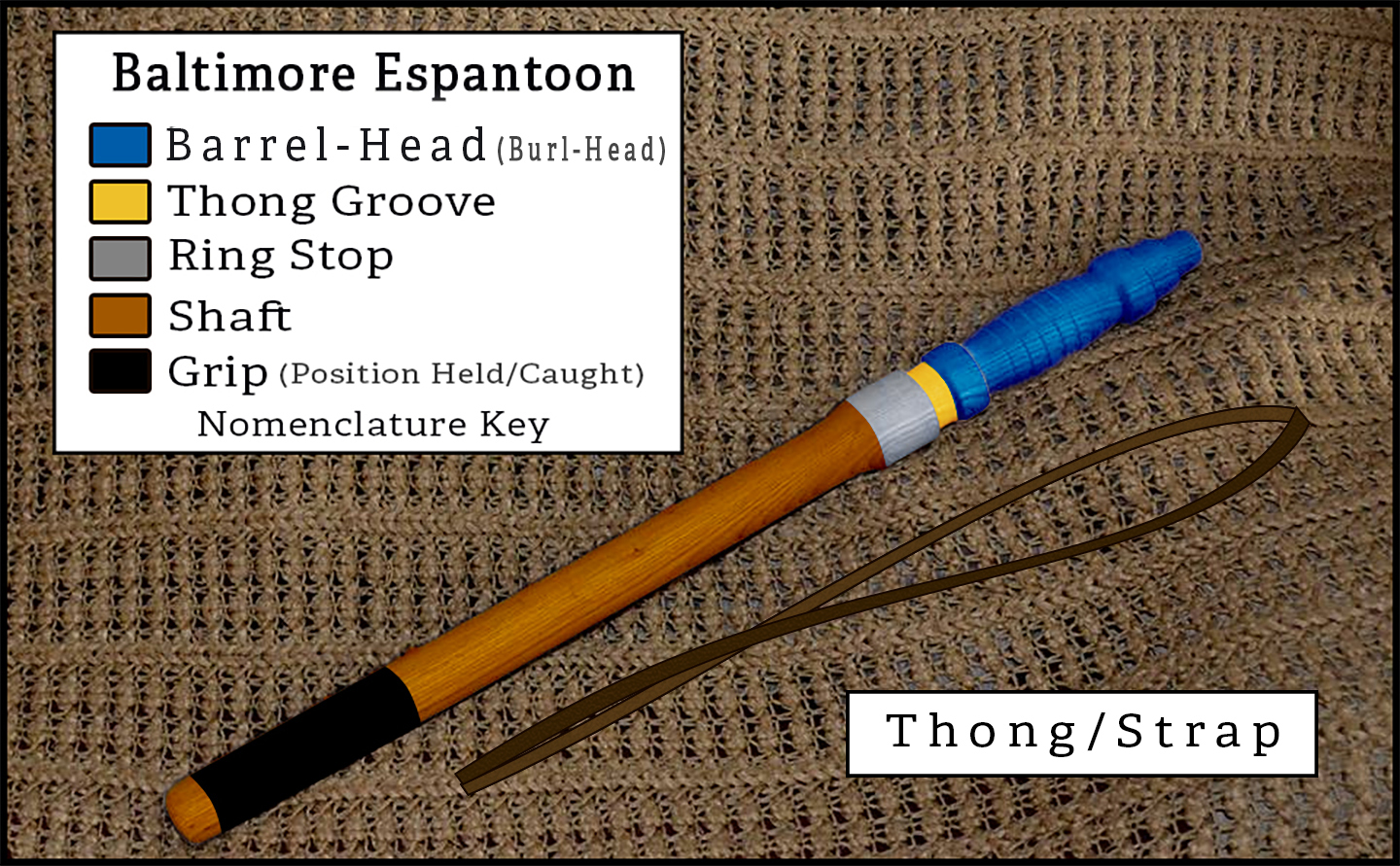
What Makes an Espantoon an Espantoon
Espantoon Info History and Nomenclature
Webster's Third Edition: defines an espantoon as follows: "An espantoon In Baltimore, a policeman's club" We would like to start out by saying we collect nightsticks, Espantoons, Batons, Truncheons, Billy Clubs, etc. If you have one for sale or that you would like to donate, please let us know, as we are interested. For what might be obvious reasons, we particularly like the Baltimore eagle. Aside from their being the stick carried by our brothers and sisters in law enforcement, they also show a progression not just in what we carried or had made, but in what the department had made for us and issued to us. That said, while we like Baltimore sticks, we collect all sticks from any state in the US and from any country in the world.
We have always been serious about the espantoon, and why is Baltimore City Police the only police department in the world that uses an espantoon? Also, why if a Baltimore County Officer and a Baltimore City Officer both have their sticks made by the same guy (let's say Nightstick Joe), why would one guy's stick be a baton or nightstick and the other be an Espantoon? We talked to several old-timers over the years, asking about the nomenclature of our Espantoon. We were told over and over that the part that looks like the handle at the top is actually not the handle and is called the "barrel head." Next to that is the "thong groove," the "ring stop," and the "shaft." The word "barrel head" might be a mispronunciation that, if correctly pronounced, may have solved this riddle much earlier, but we worked with what we had! For years, we knew the difference; we just couldn't find the words to explain it. That was until reading a newspaper article one night. When Ken read the question asked by the reporter, it was a question that flipped the switch in Ken's mind, and once it was, it was like the old saying, "It couldn't be unseen!" Now it seems we have more ways to describe or answer the question. So, what was the 1970's newspaper man's question? He asked, "If a Baltimore City Officer gifts his Espantoon to a Baltimore County Officer, is it still an Espantoon?" The answer in Ken's eyes was, no, and as odd as it may sound like so many police issues, it all comes down to training. For years, when asked what makes an Espantoon an Espantoon, the satisfactory answer was, "Webster's 3rd edition dictionary says it is!" That has not been acceptable to us, so we dug further, reading every newspaper article, every general order, and every policy. Doing so gave us what we think is the truest of answers. Baltimore turns a nightstick into an Espantoon because what looks like a "handle" is the "barrel head" (most likely originally pronounced "burl head"), whereas everywhere else in the world the part that looks like a handle is a handle, but in Baltimore City, we turn the stick around, and that handle-looking part is the striking end. If a city and county officer traded sticks, they would each take their new stick and use it according to their training, one having a nightstick with a handle and the other having an espantoon with a burl head. That is what makes a Nightstick an Espantoon. What follows is some supporting documentation on the subject.
As for the old answer, what makes an espantoon? A name for a nightstick that is only used by the Baltimore police. Here is the old answer, from the pages of Webster's 3rd edition.


We had a difficult time explaining what made an Espantoon an Espantoon, until reading that 1970's Sun Paper, newspaper article that asked, "If a Baltimore City officer gave his espantoon to a county officer, would it still be an espantoon?" This single question sparked the answer, which we've known for years but had trouble wording into a reasonable explanation.
The Baltimore Police Department's General Orders, or what today is known as Baltimore Police "Policy," specifically Policy number 1111, define the Espantoon as follows:
A wooden baton is between 22 and 25 inches in length, with the striking end of the baton being between 1-1/2 and 1-3/4 inches in diameter and the grip end being 1-3/8 inches in diameter.
This means our nightstick has a "Burl Head." But what if the county officer simply turned his baton around wouldn't that make it an espantoon? Well in theory it would, except, in Baltimore City this can be done under Policy 1111, and remain within the officer's guidelines and training, in the county the officer would be going against his, or her training, and therefore, not only wouldn't it be an espantoon, but the officer could be charged (if not criminally, at least departmentally) and quite possibly lose his or her job. So, part of it not just that we turn the stick around, it, is that it is within our agencies rules and regulations and is within our training that we use it this way, and that is what makes our baton an espantoon.

Baltimore Issued Espantoon
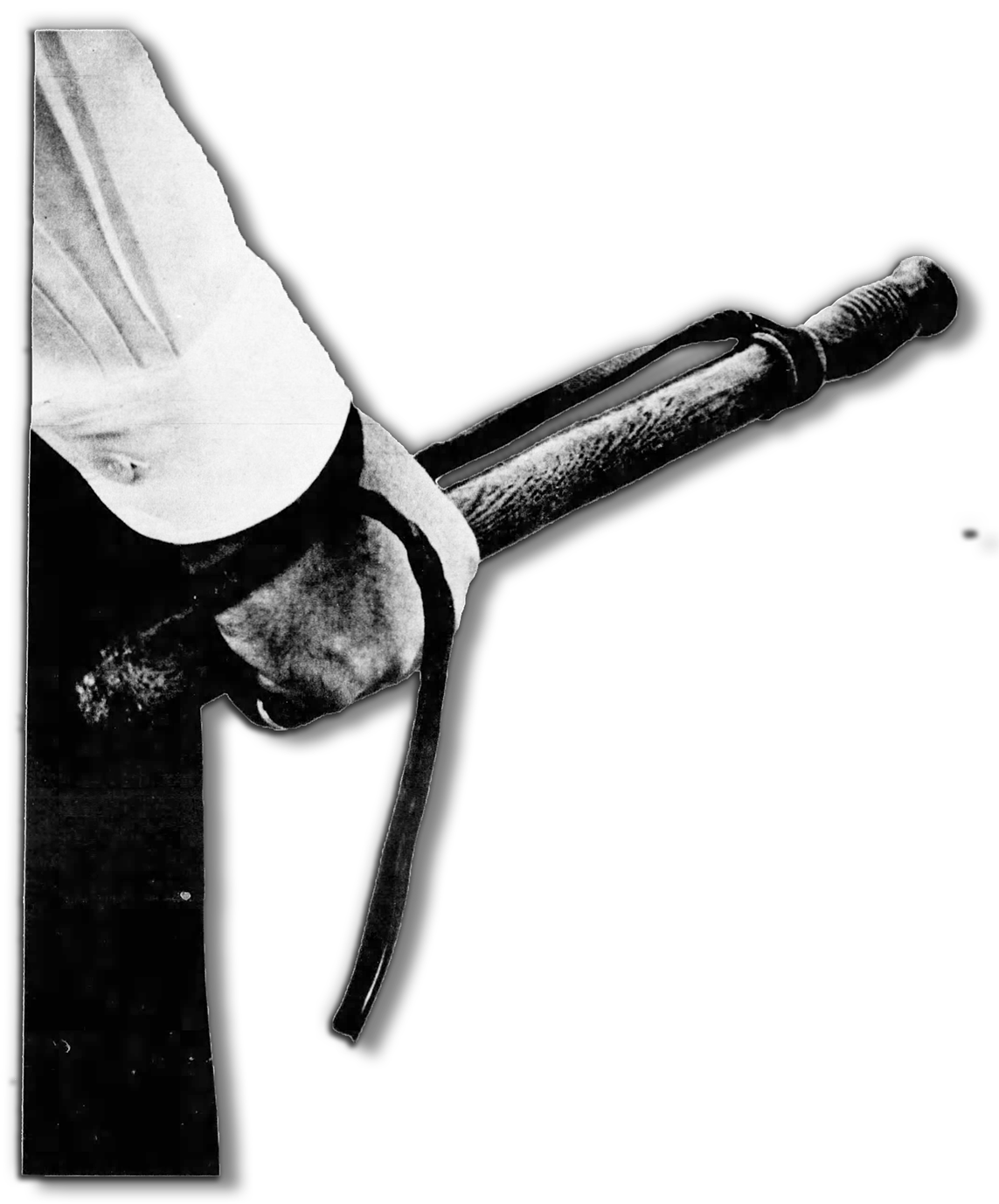
Notice in this picture that the officer is carrying his espantoon with the barrel head out. This practice has been the way Baltimore police have carried their sticks going back to the late 1700's and the early 1800s it is what makes a nightstick an espantoon. The espantoon, also known as a nightstick, is a traditional symbol of authority for Baltimore police officers. Its unique design with the barrel (or burl ) head carried outward is for self-defense and crowd control. Its uniqueness is believed to have originated here in the late 18th century and has been consistently followed ever since. With the barrel head facing outward, it allows for quick and effective strikes, or jabs while maintaining a non-threatening appearance. This longstanding practice showcases the rich history and traditions of the Baltimore police force. The distinctive carrying style has become an iconic feature of Baltimore's law enforcement history and also serves as a visual representation of their role in maintaining law and order while reflecting the city's deep-rooted connection to its policing heritage.

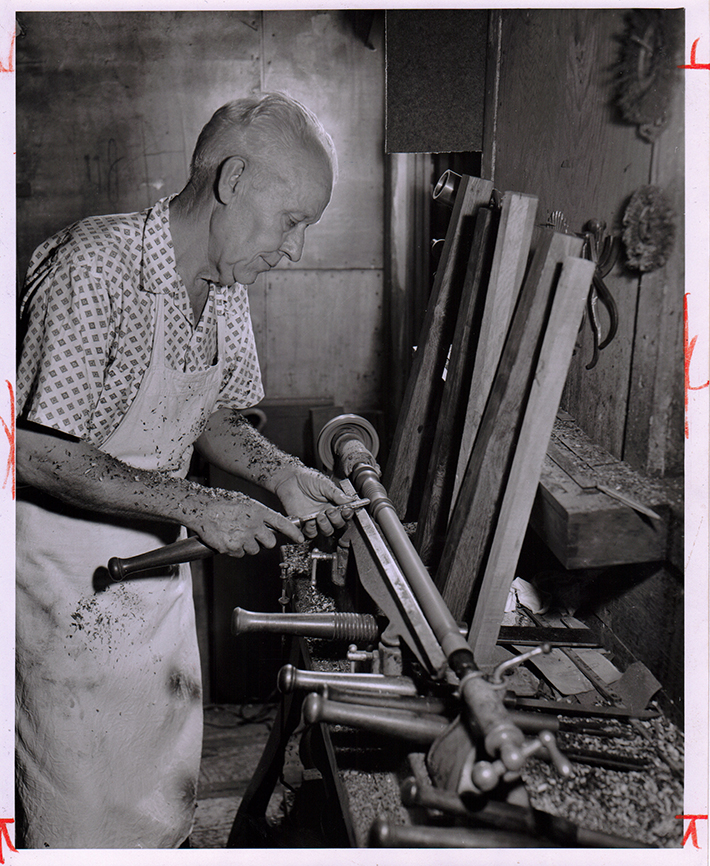
Woodworkers that Turned Baltimore Espantoons
1937 / 2007
1937 / 1957 – Rev W Gibbs McKenney - Made BPD Issue - Sold to Howard Uniform - 10000 hickory 2000 redwood over 20 yrs
1957 / 1977 – Rev. John D Longenecker - Made BPD Issue - Sold to Howard Uniform - 10000 hickory 2000 redwood over 20 yrs
1955 / 1979 – Carl Hagen - Made BPD Issue & his own Stick - Sold to Howard Uniform & Officers - 2000 various wood types over 24 yrs
1974 / 1977 – Edward Bremer - Made his own Stick – Sold to Officers - 300 various wood types over 3 yrs
1977 / 2007 – P/O Joe Hlafka - Made his own Stick - Sold to Officers and Police Supply Shops - 10,000 various wood types over 30 yrs

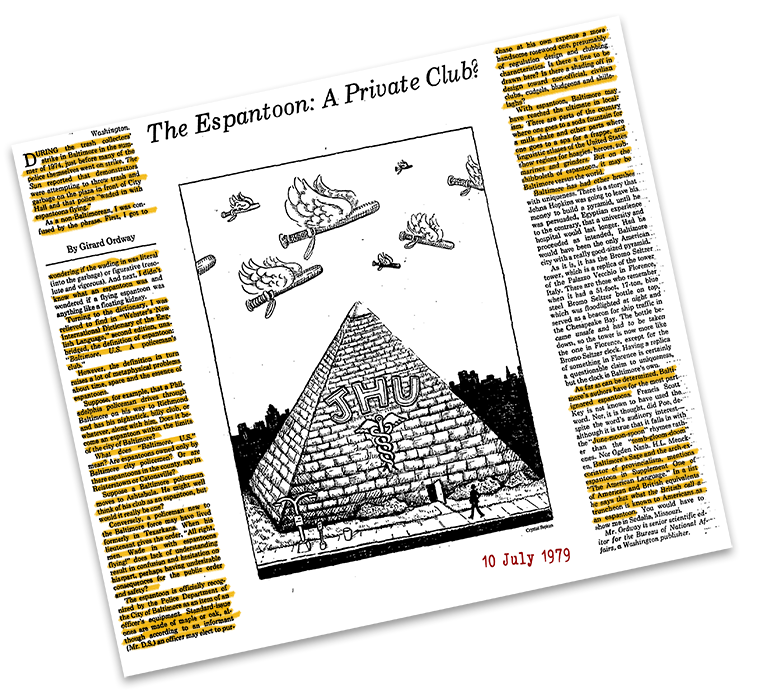
Above is the article that best helped us put our answer into words about what makes an espantoon an espantoon. To read the full article, click on the pic above or click HERE and it will take you to the article, you can click on it after it opens if you need to zoom in.
Note - Johns Hopkins was born on May 19, 1795. Raised as a member of the Society of Friends (Quakers), Johns Hopkins was known as an honest man, generous to a fault, somewhat stubborn, and hard with a bargain. He transformed himself from a grocer’s helper to a millionaire banker, and became Victorian Baltimore’s greatest philanthropist.

Johns Hopkins


The blue portion of the espantoon in the above illustration is most often mistaken as the handle of the stick but is the striking/burl end. It is called a Barrel Head, this most likely comes as the result of an error in pronunciation, as in many blunt force weapons, the striking end is called a "Burl" head. As in the Tomahawk, and other such weapons the blunt end can either be added or carved into the weapon. Here in Baltimore with years of mispronunciation and a slight southern drawl, Burl sounds more like, Barrel. So, Burl Head, became Barrel Head. A funny thing to add to this, is that shape of the Espantoon's burl as it is kind of shaped like a barrel, which added to the error. Now, in the way the JEEP a military vehicle that also has ties to Baltimore has a name that was derived from the letters G.P. for General Purpose. G.P. said often enough, and fast enough took on the sound of JEEP and long before it was manufactured and marketed as the JEEP it became JEEP and would have with, or without the JEEP's we know have forever called a Jeep, likewise, the Burl Head or the striking end of our espantoon will now and will forever be called the Barrel Head. Under the barrel head, indicated with Yellow is the thong Groove, it is where we add a leather strap aka a Thong, under the Thong groove, indicated in black here is the Ring Stop, it is a little wider to help keep the ring from falling through the Ring on our gun belt. under the Ring stop is the Shaft, it gives us reach to create distance between us and a suspect. Down around the bottom of the shaft, about an inch and half up from the bottom and maybe 3 to 4" past that is the grip, it is where we hold the stick when jabbing or swinging, and where we catch the stick while spinning. I hope that helps better understand our espantoon, its parts, how it is used different from your average nightstick. Its name most likely came from, "A Spontoon" and again over the years it may have gone from Get me a spontoon" make sure you have "a spontoon" to "espontoon" to "espantoon" some early sun paper reports 1839sh had it spelled "Spontoon" Also in pictures of Baltimore Police almost as far back as we can find, officers hold them by the Shaft end, as well on older sticks you can tell by dirt marks where the officers held them and all the marks are closer to the end of the shaft furthest away from the Barrel head.
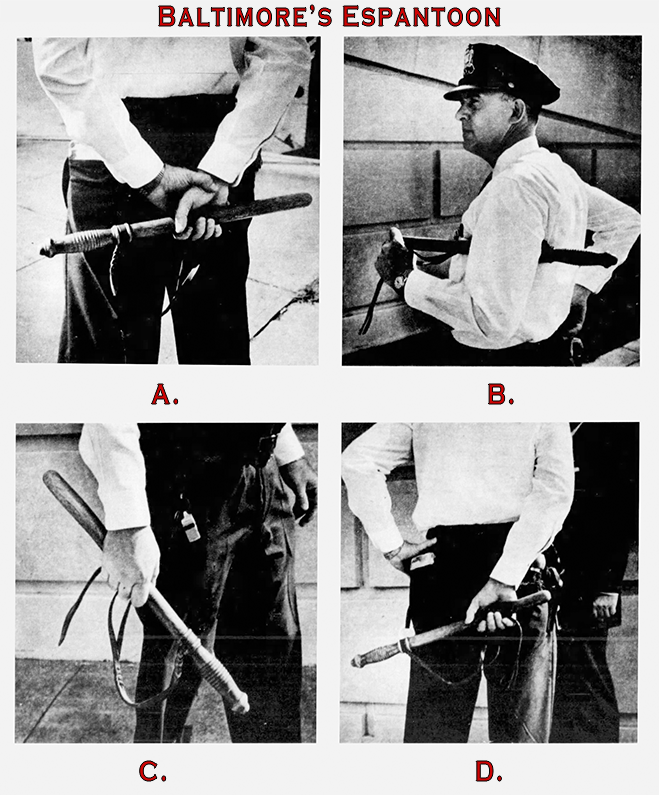
Looking at the pictures above, we can see that the Baltimore Police carry what is known to them as the espantoon. It is carried in a way that keeps the barrelhead at the ready. Tucked under the weak arm with the striking end extending out toward the officer's back, it leaves the grip end ready for the officer to grab or grip with his or her strong hand in the event that it might be needed. In photograph A) we see it in the officer's strong hand. If necessary, he could turn his hand downward with the thong over a finger of the strong hand, allowing the stick to slide out until stopped by the strap. This would put the stick in his hand by the grip end, with the striking end out, and at the officer's ready. Photograph B) is as described above, tucked under the weak arm, ready to be grabbed with the strong hand at the grip end, which would leave the striking end again at the ready. Photographs C) and D) are similar in that the officer's stick is held in the strong hand, with the thong over a finger, and the stick is held at the halfway point, or so, with the striking end pointing forward, allowing the officer to simply loosen their grip while the stick slides forward until the thong brings it to a stop, at which point the stick would be ready for use. The important thing about Photograph D) is that the stick is behind the officer's back, so while he is holding it at the ready, he is not doing anything that could be seen as a threatening move to provoke confrontation. We can now see why these 4 pictures are a nice representation of how a Baltimore officer can always be ready to protect himself or the public without walking around in a way that might be seen as or used as an excuse to claim it as having been threatening. Compare the way a Baltimore officer holds the espantoon to the way other juristictions hold their nightstick, or billy clubs.

This is the difference: These officers are not Baltimore Police
They are not wielding an Espantoon in Baltimore; this would be considered
The Wrong End of the Stick
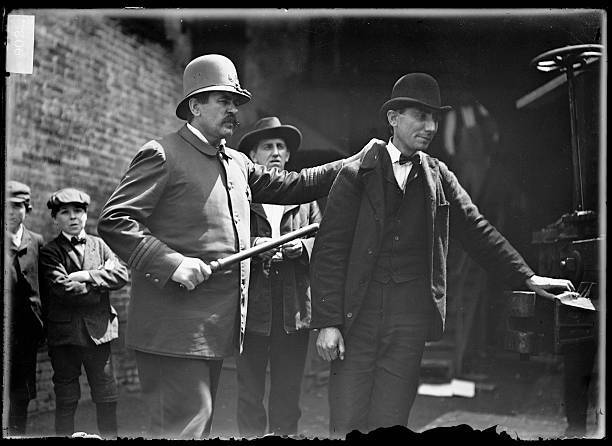
This is the difference: These officers are not Baltimore Police
They are not wielding an Espantoon in Baltimore; this would be considered
The Wrong End of the Stick

Unraveling the Espantoon
A Deep Dive into Baltimore’s Policing History with Insights
Written by OpenAI’s ChatGPT, a division of CoPilot by Bing
12 January 2024
The nightstick, also known as a baton or truncheon, is a cylindrical club that has been used as a compliance tool and defensive weapon by law enforcement officers, correctional staff, security guards, and military personnel. The term “nightstick” was first used in 1887 and is derived from the combination of “night” and "stick.”. Because police officers or watchmen carried it during their night patrols, it earned its name. The name “night stick” also refers to the usage of a longer baton at night by the NYPD, as opposed to the more discreet 11-inch “day stick” used during the dayshift. The names come from the fact that these weapons were used primarily for nighttime police work. The term “stick” in this context refers to a piece of wood, generally long and slender, that can be used as a weapon. So, the term “nightstick” essentially means a stick used at night. The use of different batons for day and night was based on the perceived level of threat and the need for protection being different during the day.
The concept of a modern police force using a club (truncheon) as a tool originated with the formation of London’s first police department in 1829 by Prime Minister Sir Robert Peel. The officers, also known as "bobbies," were armed only with a truncheon, which could be used in a variety of ways, not all of them harmful. The use of the club soon spread to American cities like New York, Boston, and Baltimore.
As for the specific invention of the nightstick, it’s difficult to attribute it to a single person or time, as similar tools have been in use since ancient times. However, the first mention of the Baltimore Police Department using a nightstick dates back to March 19, 1798.
Please note that while the nightstick has evolved over time, the basic design—a roughly cylindrical club made of wood, rubber, plastic, or metal—has largely remained unchanged. Today, most nightsticks are made of composite materials
The espantoon, a unique symbol of the Baltimore Police Department, has a rich history and distinct characteristics that set it apart from the common nightstick. This ornate wooden baton, equipped with a swiveled leather strap for ease in twirling, is more than just a tool; it’s a part of Baltimore’s cultural fabric.
The term “espantoon” is believed to have evolved from "spontoon," a weapon carried by officers in the Roman legion. However, what truly distinguishes an espantoon from a nightstick is not just its physical features but also the way it is used and held. In Baltimore, the part that appears to be a handle is actually the “barrel head” or “burl head," which is used as the striking end. This is in stark contrast to all other regions, where the part that looks like a handle is indeed used as a handle.
Retired Detective Ken Driscoll’s findings have been instrumental in understanding these nuances. According to his research, the training that the officers receive and how they use the stick determine the difference between an espantoon and a nightstick. Interestingly, Driscoll also discovered that the term “barrel head” might be a misinterpretation of “burl head," a term used to describe the striking end of impact weapons. This linguistic mix-up is thought to have occurred due to Baltimore’s rich southern drawl, leading to “burl head” being heard as “barrel head.”. To support Driscoll’s theory that the espantoon differs due to its use of a burl or barrel head, we can refer to the Department’s training policy number 1111, which describes the espantoon as follows:
Espantoon: ─ A wooden baton between 22–25 inches in length and 16–32 ounces, with the striking end of the baton being between 1.5 - 1.75 inches in diameter and the grip end being 1.375 inches in diameter. This baton has color restrictions and shall only be coated in an oak, ash, maple, hickory, or rosewood finish. Decorations are prohibited.
Right there, in black and white, policy 1111 specifies that the diameter of the striking end is between 1 1/2 inches and 1 3/4 inches, while the diameter of the grip end is described as 1 3/8 inches. So, the striking end is 1/8” to 3/8” larger in diameter than the grip end. This is a clear indication that the burl or barrel head is the striking end.”
Driscoll’s findings not only clarified the distinction between an espantoon and a nightstick but also shed light on the cultural and linguistic aspects of its usage. His work is a testament to the importance of context and local knowledge in understanding these unique aspects of Baltimore’s policing history.
In conclusion, the espantoon is more than just a tool; it’s a symbol of Baltimore’s unique policing culture and history, as the espantoon was at one time a badge of authority for Baltimore Police, and Ken Driscoll’s findings have played a crucial role in unraveling the mysteries of this important tool for Baltimore police dating back to the late 1790s.
In the Victorian era, police in London carried truncheons about one foot long called Billy clubs. The truncheon acted as the policeman’s ‘Warrant Card’ as the Royal Crest attached to it indicated the policeman’s authority. This was always removed when the equipment left official service.
Over time, the design of the nightstick has evolved to meet the changing needs of law enforcement. For example, straight batons of rubber have a softer impact. Some of the kinetic energy bends and compresses the rubber and bounces off when the object is struck. However, rubber batons are not very effective when used on the subject’s arms or legs and can still cause injury if the head is struck. That is why most police departments have stopped issuing them.
There have also been variations of the nightstick, such as the sap, slapjack, or blackjack, which is a heavy leather pouch, eight to twelve inches long, filled with lead and sometimes a flexible steel spring or rod. These were easier to conceal and could be used in close-quarters combat.
Mr. Edward Bremmer once said his espantoon saves lives, as it is one step in the escalation of violence just ahead of using a firearm. So, if the espantoon doesn’t work, officers would be forced to step up to the firearm. For that reason, Mr. Bremmer made his espantoon heavier and added what he called a “Nib” on the top of all his barrel heads. With this Nib, the officer can not only swing it in defense of himself or others, but he could also use that Nib end to jab the espantoon. Mr. Bremmer felt he has saved lives, both the lives of officers and the lives of suspects, because, as he once said, “Nightsticks prevent officers from needing to escalate from hand-to-hand combat to the use of firearms.” He also said, “The faster we can get a suspect into cuffs, the safer it is for everyone involved.” One of Mr. Bremmer's old sticks, made of Lignum vitae, a wood that the department forbade because it was too heavy, too hard, and too dangerous, is on display at the Baltimore Police Historical Society. The department felt the stick of that material could cause serious injury or death.
Today, most nightsticks are made of composite materials, and their use has declined with the advent of other law enforcement tools like TASERs and pepper spray. However, they still remain a part of the law enforcement toolkit in many jurisdictions.

The Espantoon and the "Tune-Up"
A Baltimore Police Relic and Its Murky Origins
Introduction:
Within the annals of Baltimore Police Department history, certain terms evoke a starkly different era. Among them, "espantoon" and "tune-up" stand out, relics of a time when policing was often more direct and, some might argue, more brutal. This article delves into the potential origins of these terms, particularly focusing on the "espantoon" – a baton that played a significant role in crowd control and, allegedly, individual encounters. It also examines the chilling phrase "tune-up," and how it may be connected to the use of this tool.
The Espantoon: From Spontoon to Nightstick?
The word "espantoon" itself is a linguistic puzzle. The prevailing theory suggests it evolved from "spontoon," a historical term for a type of polearm, often carried by military officers. 1 The transition from "spontoon" to "espantoon" likely occurred through a process of phonetic drift, possibly influenced by the spoken language of the time.
A crucial point to consider is the historical context. In the 1970s and 80s, the Baltimore Police Department, like many urban forces, faced significant challenges related to crime and civil unrest. During this period, the "espantoon" – essentially a long, wooden baton – was a standard piece of equipment.
The term "nightstick" also comes into play. It is believed that the longer baton was carried at night, and the shorter baton was carried during the day. During periods of civil unrest, or large gatherings, buckets of the longer batons would be brought to the scene for distribution.
The hypothesis that "a spontoon" became "aspontoon" and then "espantoon" is intriguing. Oral traditions and rapid communication during chaotic situations could easily lead to such linguistic shifts. Furthermore, early records may have shown variations in spelling (like "Spontoon"), further supporting this idea.
The "Burl Head" and "Barrel Head"
Adding to the complexity, the striking end of the espantoon, often referred to as the "barrel head," is likely a misnomer. Veteran officers have suggested that the term originated from "burl head," referring to the naturally occurring burl wood used in the baton's construction. Due to the visual resemblance to a small barrel and the influence of Baltimore's southern-tinged dialect, "barrel head" became the common term. This highlights the importance of considering regional dialects when tracing the origins of terms.
The "Tune-Up": A Euphemism for Force?
The phrase "tune-up" is where the story takes a darker turn. In the context of Baltimore policing, it's widely understood to refer to the use of the espantoon to subdue or punish individuals. This euphemism, while seemingly innocuous, carries a heavy weight.
The theory that "toon-up" became "tune-up" as a play on words related to the "espantoon" is a compelling, if speculative, explanation. It's plausible that officers, seeking to mask the brutality of their actions, adopted a seemingly more benign term. This also speaks to the use of police culture, and the use of language to obfuscate, or to give a level of separation from the action being taken.
The use of euphemisms in law enforcement is not uncommon. It allows for the discussion of sensitive topics without explicitly detailing the violence involved. However, it also serves to obscure the reality of police actions, potentially contributing to a culture of impunity.
Speculation and Historical Context:
It's important to acknowledge that the origins of these terms are not definitively known. Much of the information comes from oral history, which can be subject to inaccuracies and embellishments over time.
However, the speculation surrounding the "espantoon" "toon-up" and "tune-up" provides valuable insights into the history of policing in Baltimore. It highlights the challenges faced by law enforcement during a turbulent period, as well as the potential for abuse of power. The tool itself, and its unique use within the Baltimore police force, is what created the unique words used.
Oral Tradition and Local Dialect:
The role of oral tradition in preserving and transforming these terms cannot be overstated. Baltimore's unique dialect played a crucial role in the pronunciation and evolution of these words. The practicality of the "espantoon" and the need for discreet communication likely contributed to the development of the "tune-up" euphemism.
Conclusion:
The "espantoon" and the "tune-up" are more than just words. They represent a chapter in Baltimore's history that is both complex and controversial. While the exact origins of these terms may remain shrouded in mystery, their legacy continues to shape the conversation about policing and accountability.
Further Research:
- Archival research into Baltimore Police Department records from the 1970s and 80s.
- Interviews with retired police officers who served during that period.
- Linguistic analysis of the evolution of the terms "spontoon" and "espantoon."
By continuing to explore these topics, we can gain a deeper understanding of the past and work towards a more just and equitable future.

The History and Design of Burl-Head Weapons Across Cultures
Weapons have been an essential part of human history, evolving alongside societies to meet their defensive and offensive needs. One intriguing design element that appears across various cultures is the "burl head" or a similar feature, which enhances the weapon's effectiveness by providing a more substantial striking surface.
The Baltimore Espantoon
The term "burl head" is often associated with the Baltimore police's espantoon, a distinctive nightstick or baton. The espantoon features a part known as the "burl head" (a mispronunciation of "barrel head"), which is the striking end of the baton. This design is unique to the Baltimore City Police and includes other components such as the thong groove, the ring stop, and the shaft.
African Knobkerries
In African cultures, particularly in Southern Africa, a traditional weapon known as the knobkerrie features a similar design. The knobkerrie is a wooden club with a rounded, often carved, striking end. This burl-like feature is either carved out of the same piece of wood or added separately, enhancing the weapon's impact. Knobkerries are used both as tools and weapons, reflecting the versatility and ingenuity of their design.
Native American War Clubs
Native American cultures also developed weapons with similar characteristics. The ball-headed war club, used by various Native American tribes, features a rounded, sometimes intricately carved, striking end. These war clubs were effective in close combat and symbolized the warrior's status and skills. The carved designs often held cultural and spiritual significance, adding an extra layer of meaning to these formidable weapons.
Other Cultural Examples
Beyond Africa and Native America, other cultures have independently developed similar designs for their traditional weapons. For instance, in Polynesian societies, the mere and patu are short clubs with broad, flat striking surfaces, often adorned with intricate carvings. These weapons, like their counterparts in other cultures, were both practical tools and symbols of power and authority.
Conclusion
The recurring design of the burl-head or similar features in traditional weapons across different cultures highlights the universal human ingenuity in creating effective tools for combat and survival. These weapons not only served their practical purposes but also carried cultural, spiritual, and social significance. As we study these artifacts, we gain a deeper appreciation for the diverse ways in which human societies have approached the challenges of defense and warfare throughout history.

POLICE INFORMATION
If you have copies of: your Baltimore Police Department class photo; pictures of our officers, vehicles, and equipment; newspaper articles relating to our department and/or officers; old departmental newsletters; lookouts; wanted posters; or brochures. Information on deceased officers and anything that may help preserve the history and proud traditions of this agency. Please contact retired detective Kenny Driscoll.
This email address is being protected from spambots. You need JavaScript enabled to view it.

NOTICE
How to Dispose of Old Police Items
Please contact Det. Ret. Kenny Driscoll if you have any pictures of you or your family members and wish them remembered here on this tribute site to Honor the fine men and women who have served with Honor and Distinction at the Baltimore Police Department. Anyone with information, photographs, memorabilia, or other "Baltimore City Police" items can contact Ret. Det. Kenny Driscoll at This email address is being protected from spambots. You need JavaScript enabled to view it. follow us on Twitter @BaltoPoliceHist or like us on Facebook or mail pics to 8138 Dundalk Ave. Baltimore Md. 21222
Copyright © 2002 Baltimore City Police History - Ret Det Kenny Driscoll




























